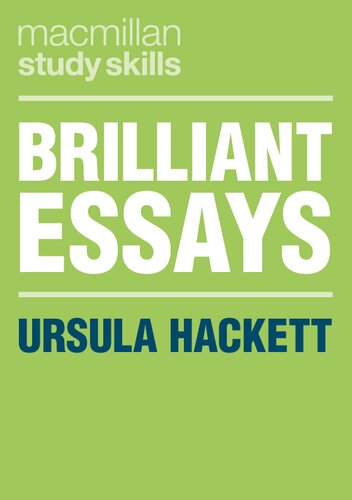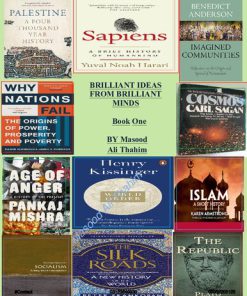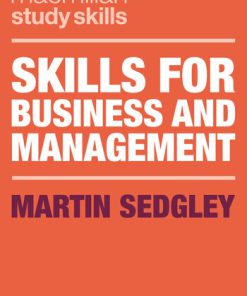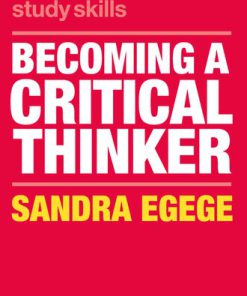Brilliant Essays Macmillan Study Skills 1st editon by Ursula Hackett ISBN 1352011379 978-1352011371
$50.00 Original price was: $50.00.$25.00Current price is: $25.00.
Brilliant Essays Macmillan Study Skills 1st editon by Ursula Hackett – Ebook PDF Instant Download/Delivery: 1352011379, 978-1352011371
Full dowload Brilliant Essays Macmillan Study Skills 1st editon after payment

Product details:
ISBN 10: 1352011379
ISBN 13: 978-1352011371
Author: Ursula Hackett
Ursula Hackett’s tried-and-tested approach for essay success helps students to create brilliant, original, high-scoring essays that are enjoyable to write – and read. With dozens of hands-on exercises and clear examples, Brilliant Essays begins with students’ everyday experience of using language, arguing a case, reading, thinking, and communicating with other people. Chapters help students to examine – and dispel – assumptions, build and control their arguments and use evidence effectively, in written assignments and timed exams. The final chapter provides clear, no-nonsense answers to frequently asked questions raised by Ursula’s students at Royal Holloway, University of London and the University of Oxford and via her YouTube channel and website.
Whichever subject your students study, Brilliant Essays will take them beyond the basics and give them the tools to reach their academic potential.
Brilliant Essays Macmillan Study Skills 1st Table of contents:
CHAPTER
1: Examining Assumptions in Questions
Finding an assumption lurking beneath the surface
Chapter 1 Exercises
Examining assumptions in questions
CHAPTER
2: Finding Comparator Classes in Questions
Emphasizing words to find comparators
Chapter 2 Exercises Finding comparator classes in questions
Chapter 2 Exercises Finding comparator classes in questions
CHAPTER
3: Interrogating Tensions in Questions
BUT: Are your propositions complementary or in tension?
OR: Are your options mutually exclusive and collectively exhaustive?
Why questions
‘How’, ‘what’ and ‘when’ questions
Chapter 3 Exercises Interrogating tensions in questions
Chapter 3 Exercises Interrogating tensions in questions
Chapter
4: The Introduction Scale
Level 1 introductions identify a question
Level 2 introductions offer a bare ‘agree’ or ‘disagree’
Level 3 introductions present the author’s view
Level 4 introductions explain the author’s view
Chapter 4 Exercises The introduction scale
Chapter 4 Exercises The introduction scale
CHAPTER
5: Controlling Your Argument
Be ruthless
Avoid the voyage of discovery
Don’t move off-piste
Spill the beans
Chapter 5 Exercises Controlling your argument
Chapter 5 Exercises Controlling your argument
CHAPTER
6: Writing Elegantly
Excessive signposting
Compulsive hedging
Writing about academia versus writing about the subject matter
Avoid slipping between empirical and emotional statements
Why get rid of hedging and signposting?
Chapter 6 Exercises Writing elegantly
Chapter 6 Exercises Writing elegantly
CHAPTER
7: Using Empirical Evidence Effectively
Be systematic in your approach
Of what is this a case? Compared with what?
Typical and telling cases
Hard and easy cases
Chapter 7 Exercises Using empirical evidence effectively
Chapter 7 Exercises Using empirical evidence effectively
CHAPTER
8: Syllogisms and Summaries
Summarizing effectively by paraphrasing an argument
Using syllogisms to boost the power of your arguments
Using syllogisms to problematize a question
Chapter 8 Exercises Syllogisms and summaries
Chapter 8 Exercises Syllogisms and summaries
CHAPTER
9: Losing the Training Wheels
Training wheel #1: The pro–con procedure
Training wheel #2: Eliminating all uses of the word ‘I’
Training wheel #3: Defining your terms and moving on
Getting rid of tired old formulas for essay writing
Chapter 9 Exercises Losing the training wheels
Chapter 9 Exercises Losing the training wheels
CHAPTER
10: Reading Critically
Active reading
Note-taking
Questions to ask yourself as you read
Mapping out causal mechanisms and arguments as diagrams
Chapter 10 Exercises Reading critically
Chapter 10 Exercises Reading critically
CHAPTER
11: Examination Preparation
Prioritizing thinking time and avoiding word wastage
Revising well
Handwritten essays
Chapter 11 Exercises Examination preparation
Chapter 11 Exercises Examination preparation
CHAPTER
12: Frequently Asked Questions
General questions
Questions about reading
Questions about evidence
Questions about examinations
Questions about anxiety and confidence
Conclusion: Techniques for Writing Brilliant Essays
Answers to Chapter 1 Exercises
Have a go at finding hidden assumptions
Answers to Chapter 2 Exercises
Have a go at finding different comparator classes
Answers to Chapter 3 Exercises
Have a go at uncovering false dichotomies (or trichotomies)
Have a go at identifying assumptions in ‘how’, ‘when’ and ‘why’ questions
Answers to Chapter 4 Exercises
Have a go at deducing the question from the introductory paragraphs
Have a go at identifying the question steer
Have a go at identifying a logical essay structure
Answers to Chapter 5 Exercises
Have a go at cutting basic background information
Have a go at staying on-piste
Have a go at spilling the beans
Answers to Chapter 6 Exercises
Have a go at avoiding excessive signposting
Have a go at avoiding compulsive hedging
Have a go at identifying the world of studying and the world of ideas
Have a go at separating empirical and emotional statements
Answers to Chapter 7 Exercises
Have a go at identifying core empirical cases and data
Have a go at situating an example within different comparator classes
Have a go at identifying hard and easy cases
Answers to Chapter 8 Exercises
Have a go at moving from general theme to proposition
Have a go at paraphrasing
Have a go at writing an argument as a syllogism
Answers to Chapter 9 Exercises
Have a go at responding to counter-arguments
Have a go at identifying appropriate uses of ‘I’, ‘me’, ‘my’ and the passive voice
Have a go at identifying different definitions
Answers to Chapter 10 Exercises
Have a go at rewriting definitions in your own words
Have a go at joining up the dots
Answers to Chapter 11 Exercises
Have a go at avoiding word wastage
Have a go at rote learning for examinations
Have a go at examination planning
Answers to Chapter Exercises
End of Chapter 1 Exercises: Examining assumptions in questions
End of Chapter 2 Exercises: Finding comparator classes in questions
End of Chapter 3 Exercises: Interrogating tensions in questions
End of Chapter 4 Exercises: The introduction scale
End of Chapter 5 Exercises: Controlling your argument
End of Chapter 6 Exercises: Writing elegantly
End of Chapter 7 Exercises: Using empirical evidence effectively
End of Chapter 8 Exercises: Syllogisms and summaries
End of Chapter 9 Exercises: Losing the training wheels
End of Chapter 10 Exercises: Reading critically
End of Chapter 11 Exercises: Examination preparation
References
People also search for Brilliant Essays Macmillan Study Skills 1st:
macmillan early skills program
a brilliant solution carol berkin sparknotes
a brilliant madness summary
a brilliant beetle
You may also like…
Romance - Military Romance
Education Studies & Teaching - Studying & Test Preparation
Skills for Business and Management (Macmillan Study Skills, 76) 1st Edition Martin Sedgley
Mathematics
How to Analyze Data Pocket Study Skills 1st edition by Catrin Radcliffe 1137608471 9781137608475
Education Studies & Teaching
Study Skills for Foundation Degrees 3rd Edition Dorothy Bedford
Education Studies & Teaching - Studying & Test Preparation
Ace Your Exam (Macmillan Study Skills) by Northedge 9781352011357 1352011352
Uncategorized
Study Skills for International Postgraduates Bloomsbury Study Skills 2nd Edition Martin Davies
Education Studies & Teaching - Studying & Test Preparation
Education Studies & Teaching - Studying & Test Preparation
Becoming a Critical Thinker 1st Edition by Sandra Egege ISBN 9781352011333 1352011336











